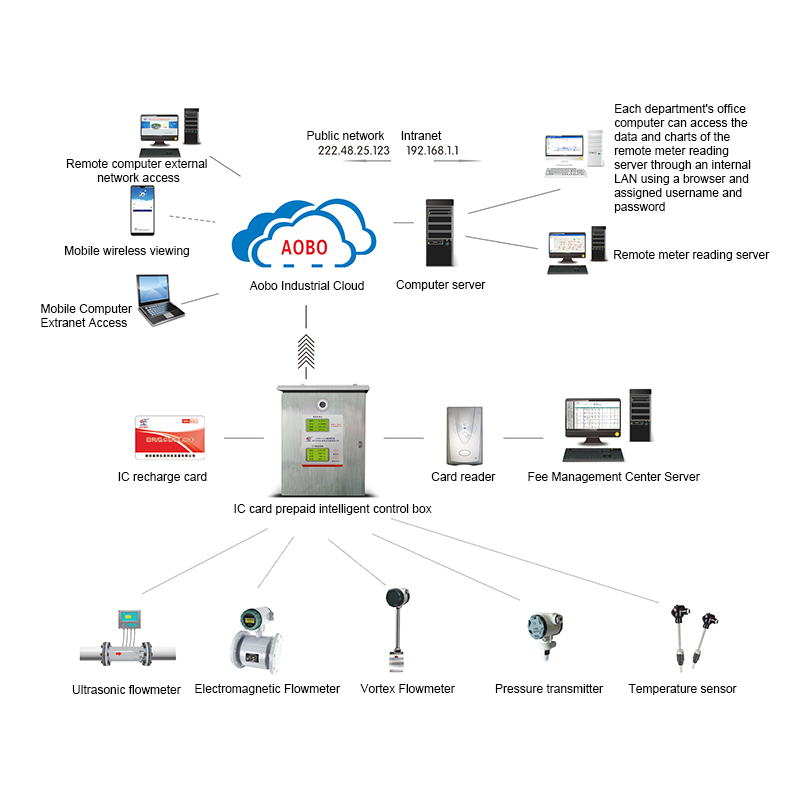

Solution
Location:Home - Solution
Solutions for the HVAC industry
The country vigorously advocates "energy conservation and emission reduction", and people's requirements for comfortable environments continue to increase, bringing great potential to the application of HVAC systems in buildings. The energy-saving of HVAC systems is increasingly receiving attention and attention.
Taking central air conditioning as an example, the original billing system was calculated based on area, but later went through various billing methods such as water meter metering, electricity meter metering, and time metering. However, no matter which method was used, it could not truly reflect the essence of air conditioning's "quantity", resulting in unreasonable results, resulting in billing disputes and energy waste. Therefore, finding an economical and practical central air conditioning metering and charging method that meets the application situation of domestic central air conditioning has become the unremitting pursuit of knowledgeable individuals in the industry.
The "amount" to be calculated for central air conditioning is the amount of energy consumed (heat exchange). Therefore, energy meter billing has emerged. Energy meter billing is based on measuring the water consumption and temperature difference at the end of the user's air conditioning system using a heat meter as the basis for charging. At the same time, the actual cooling capacity of the central air conditioning system is evaluated using the data from the energy meter. A database is established based on historical data, and the energy-saving potential of the building is analyzed and studied through actual data analysis. Therefore, energy-saving renovation of the building is implemented, advocating for users to use air conditioning reasonably and actively save energy, Avoid waste; On the other hand, to solve the problem of difficult charging for property management companies, users can "use more, use less, and pay less", ensuring that fees are based on evidence. Therefore, the reasonable selection of flow meters is crucial.
In low-temperature environments, the pipeline system generates a large amount of condensed water, which puts higher requirements on the structure of the cold and heat meter;
Due to changes in system design or actual load, HVAC systems often operate under high flow rates and small temperature differences, with a small difference in supply and return water temperature, usually maintained below 5 ℃. The minimum temperature difference of the cold and heat meter must be less than 2 ℃ to ensure measurement accuracy requirements and reduce system errors.
The flow rate of the air conditioning water system is greatly affected by the season, with a large flow rate in summer and winter, and a very small flow rate in spring and autumn. Additionally, there is a characteristic of a large flow rate during the day and a small flow rate at night, which puts higher requirements on the range ratio of the flow meter in the cold and hot meters;
Due to the installation location of the flow meter being hidden in a difficult to view area, it is difficult to read the meter. It is recommended to choose an instrument with a communication interface.
【Solution】
Our company suggests choosing the high-end product "AOBO-LCT Dual Channel Ultrasonic Flowmeter", which is independently developed and produced by our company and can compete with imported brands.
This dual channel ultrasonic flowmeter, which is "benchmarking and surpassing, replacing imports," has obtained 1 invention patent certificate, 6 utility model patent certificates, and 1 computer software copyright registration certificate.
The advantages of the dual channel ultrasonic flowmeter produced by Weifang Aobo Instrument are as follows:
1. Dual channel, full pass pipe section, non reducing, split installation.
2. No interruption of current for online maintenance and replacement of probes.
3. High dynamic response, the instrument has no difference between calibration mode and usage mode. During normal use, the sampling frequency of flow rate per second is not less than 40-200 times, with strong resistance to bubbles and interference.
4. Equipped with simulation function.
5. Wall mounted converter: LCD display with backlight control, displaying parameters such as instantaneous flow rate and cumulative flow rate; Supports 2 standard current signal inputs; The instrument supports two standard current signal outputs and two high-speed pulse signal outputs simultaneously. AC220V and DC12V dual power supply. Equipped with RS485/232 communication interface and standard Modbus communication protocol.
6. Equipped with intelligent flow and heat totalizer and temperature sensor, cold and heat calculation can be carried out.
7. Select a GPRS data transmission module to upload on-site data to a remote meter reading platform for real-time monitoring and management of data;
8. Equipped with an IC card prepaid intelligent metering control system, achieving a "pay first, then use energy" mode, completely solving the problem of arrears.
